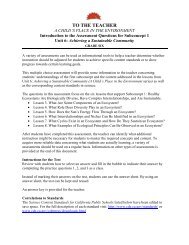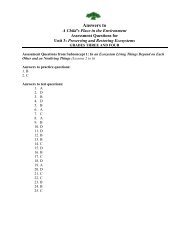Subconcept 3: Living Things Are Interdependent - A Child's Place in ...
Subconcept 3: Living Things Are Interdependent - A Child's Place in ...
Subconcept 3: Living Things Are Interdependent - A Child's Place in ...
You also want an ePaper? Increase the reach of your titles
YUMPU automatically turns print PDFs into web optimized ePapers that Google loves.
TO THE TEACHER<br />
A CHILD’S PLACE IN THE ENVIRONMENT<br />
Introduction to the Assessment Questions for <strong>Subconcept</strong>s 3 and 4<br />
Unit 1: Respect<strong>in</strong>g <strong>Liv<strong>in</strong>g</strong> <strong>Th<strong>in</strong>gs</strong><br />
A variety of assessments can be used as <strong>in</strong>formational tools to help a teacher determ<strong>in</strong>e whether<br />
<strong>in</strong>struction should be adjusted for students to achieve specific content standards or to show<br />
progress towards certa<strong>in</strong> learn<strong>in</strong>g goals.<br />
This multiple choice assessment will provide some <strong>in</strong>formation to the teacher concern<strong>in</strong>g<br />
students’ understand<strong>in</strong>gs of the third and fourth subconcepts and the content addressed <strong>in</strong> the<br />
lessons from Unit 1: Respect<strong>in</strong>g <strong>Liv<strong>in</strong>g</strong> <strong>Th<strong>in</strong>gs</strong> (A Child’s <strong>Place</strong> <strong>in</strong> the Environment series) as<br />
well as the correspond<strong>in</strong>g content standards <strong>in</strong> science.<br />
The questions <strong>in</strong> this assessment focus on the seven lessons that support <strong>Subconcept</strong> 3: <strong>Liv<strong>in</strong>g</strong><br />
<strong>Th<strong>in</strong>gs</strong> <strong>Are</strong> <strong>Interdependent</strong>; and <strong>Subconcept</strong> 4: People Can Choose to Care About and Protect<br />
<strong>Liv<strong>in</strong>g</strong> <strong>Th<strong>in</strong>gs</strong>.<br />
• Lesson 12: What Is a Food Cha<strong>in</strong>?<br />
• Lesson 13: What Is a Food Web?<br />
• Lesson 14: What Jobs <strong>Are</strong> Important <strong>in</strong> an Environment?<br />
• Lesson 15: What Can Be Observed <strong>in</strong> a Natural Community?<br />
• Lesson 16: How Do People Care About and Protect <strong>Liv<strong>in</strong>g</strong> <strong>Th<strong>in</strong>gs</strong> and Their<br />
Environment?<br />
• Lesson 17: How Can We Show We Care About <strong>Liv<strong>in</strong>g</strong> <strong>Th<strong>in</strong>gs</strong>?<br />
• Lesson 18: What Class Project Can Be Completed to Show Respect for <strong>Liv<strong>in</strong>g</strong> <strong>Th<strong>in</strong>gs</strong>?<br />
After students have completed this assessment, the teacher can identify what additional<br />
<strong>in</strong>struction might be necessary for students to master the required concepts and content. To<br />
acquire more reliable data concern<strong>in</strong>g what students are actually learn<strong>in</strong>g, a variety of<br />
assessments should be used on a regular basis. Information on other types of assessments is<br />
provided at the end of this document.<br />
Instructions for the Test<br />
Teach students how to select an answer and fill <strong>in</strong> the bubble to <strong>in</strong>dicate their answer by<br />
complet<strong>in</strong>g the practice questions 1, 2, and 3 as a class. Then read each question to students as<br />
they look at their copies of the questions and ask them to fill <strong>in</strong> the bubble for the answer they<br />
th<strong>in</strong>k is correct.<br />
Some teachers ask students to first place their f<strong>in</strong>gers on a specific question as the teacher reads<br />
it. Next, students are asked to po<strong>in</strong>t to each answer as it is be<strong>in</strong>g read. Then the teacher re-reads<br />
the four answers, as students fill <strong>in</strong> the bubble <strong>in</strong> front of the answer they th<strong>in</strong>k is correct. If<br />
students are hav<strong>in</strong>g trouble fill<strong>in</strong>g <strong>in</strong> a bubble, they can circle the answer they th<strong>in</strong>k is correct.<br />
An answer key is provided for the teacher.
Correlations to Standards<br />
The Science Content Standards for California Public Schools listed below have been edited to<br />
save space. For the full description of each standard visit: http://www.cde.ca.gov/standards/ or<br />
www.cde.ca.gov/cdepress/downloads.html<br />
Lessons 12 through 18 <strong>in</strong> Respect<strong>in</strong>g <strong>Liv<strong>in</strong>g</strong> <strong>Th<strong>in</strong>gs</strong> address the follow<strong>in</strong>g science content<br />
standards for California schools for grade one:<br />
2b – Plants, animals need water; plants also need light.<br />
2c – Animals eat plants, other animals for food.<br />
4a – Draw features of th<strong>in</strong>g described.<br />
4e – Make new observations if discrepancies exist.<br />
Other Types of Assessments<br />
This assessment should not be viewed as the only way to assess students. Us<strong>in</strong>g the constructive<br />
response method that has students write explanations, rationale, predictions, and experimental<br />
design is an effective way to determ<strong>in</strong>e what students are learn<strong>in</strong>g. Not only should questions be<br />
used to prompt learners to demonstrate their knowledge and understand<strong>in</strong>g, but also a variety of<br />
tasks could show what skills students have learned. For example, performance-based tasks allow<br />
students to show what they understand by apply<strong>in</strong>g their knowledge to various situations. For<br />
<strong>in</strong>formation on various types of assessments, guidel<strong>in</strong>es for us<strong>in</strong>g assessments, etc. visit the<br />
follow<strong>in</strong>g websites:<br />
• “Assessment for Learn<strong>in</strong>g” from the Qualifications and Curriculum Authority <strong>in</strong> London<br />
(“Assessment for Learn<strong>in</strong>g is the process of seek<strong>in</strong>g and <strong>in</strong>terpret<strong>in</strong>g evidence for use by<br />
learners and their teachers to decide where the learners are <strong>in</strong> their learn<strong>in</strong>g, where they need<br />
to go and how best to get there.”)<br />
http://www.qca.org.uk/ca/5-14/afl/<br />
• “Assessment for Learn<strong>in</strong>g: 10 Pr<strong>in</strong>ciples” from The Assessment Reform Group Institute of<br />
Education University of London (“The aim of the Assessment Reform Group is to ensure<br />
that public policy at all levels takes account of relevant research <strong>in</strong> assessment practice.”)<br />
http://www.assessment-reform-group.org.uk/pr<strong>in</strong>ciples.html<br />
• “Assessment” from WestEd <strong>in</strong> San Francisco (“Specialists at WestEd create resource<br />
materials <strong>in</strong> assessment design and provide services <strong>in</strong> the development, implementation,<br />
and evaluation of state and local assessments — tests that measure the performance of<br />
teachers as well as students.”)<br />
http://www.wested.org/
A Child’s <strong>Place</strong> <strong>in</strong> the Environment<br />
ASSESSMENT QUESTIONS FOR UNIT 1:<br />
Respect<strong>in</strong>g <strong>Liv<strong>in</strong>g</strong> <strong>Th<strong>in</strong>gs</strong><br />
GRADE ONE<br />
<strong>Subconcept</strong> 3: <strong>Liv<strong>in</strong>g</strong> <strong>Th<strong>in</strong>gs</strong> Have Needs (Lessons 12 to 15)<br />
<strong>Subconcept</strong> 4: People Can Choose to Care About and Protect <strong>Liv<strong>in</strong>g</strong> <strong>Th<strong>in</strong>gs</strong> (Lessons 16 to 18)<br />
Name: _____________________________________ Date:___________________<br />
Complete the follow<strong>in</strong>g three practice questions as a class:<br />
1. This is a picture of a:<br />
! A. cat.<br />
! B. mouse.<br />
! C. dog.<br />
! D. bird.<br />
2. Which of the follow<strong>in</strong>g is a liv<strong>in</strong>g th<strong>in</strong>g?<br />
! A. ! B. ! C. ! D.<br />
Jay and Amy went on a field trip to a park.<br />
3. What liv<strong>in</strong>g th<strong>in</strong>gs might they f<strong>in</strong>d at the park?<br />
! A. ! B. ! C. ! D.<br />
-1-
BEGIN TEST<br />
Questions for Lesson 12<br />
1. Which set of pictures below shows a food cha<strong>in</strong>? (Each arrow po<strong>in</strong>ts<br />
toward the th<strong>in</strong>g that eats it.)<br />
! A. ____________________________________________________<br />
! B. ____________________________________________________<br />
! C. ____________________________________________________<br />
! D. ____________________________________________________<br />
-2-
Complete the food cha<strong>in</strong>.<br />
Grass is eaten by ? which is eaten by a person<br />
2. What is miss<strong>in</strong>g from the food cha<strong>in</strong> above?<br />
! A. Moth ! B. Cow ! C. Frog ! D. Spider<br />
Complete the food cha<strong>in</strong>.<br />
? is eaten by a grasshopper, which is eaten by a frog<br />
3. What is miss<strong>in</strong>g from the above food cha<strong>in</strong>?<br />
! A. Grass ! B. Moth ! C. Cow ! D. Fish<br />
Questions for Lesson 13<br />
4. What would not be part of a food web?<br />
! A. Bird ! B. Beetle ! C. Bicycle ! D. Grass<br />
-3-
5. What do most food webs conta<strong>in</strong>?<br />
! A. Only plants<br />
! B. Only animals<br />
! C. Water<br />
! D. Plants and animals<br />
Questions for Lesson 14<br />
6. What is one job of a flower?<br />
! A. ! B. ! C. ! D.<br />
To make nectar To make To make ra<strong>in</strong> To make food<br />
for bees sunsh<strong>in</strong>e for sharks<br />
7. What is one job of a spider?<br />
! A. ! B. ! C. ! D.<br />
To eat birds To play <strong>in</strong> To eat <strong>in</strong>sects To climb the<br />
the sunsh<strong>in</strong>e<br />
waterspout<br />
-4-
8. In a forest, one important job of trees is to:<br />
! A. keep the air clean.<br />
! B. stop traffic.<br />
! C. be a toothpick.<br />
! D. hold laundry.<br />
Questions for Lesson 15<br />
9. Which liv<strong>in</strong>g th<strong>in</strong>g can be a home for a bird?<br />
! A. ! B. ! C. ! D.<br />
-5-
Jay and Amy went on a field trip to a park.<br />
10. What liv<strong>in</strong>g th<strong>in</strong>gs might they f<strong>in</strong>d at the park?<br />
! A. ! B. ! C. ! D.<br />
11. Amy looked for liv<strong>in</strong>g th<strong>in</strong>gs under a rock. What might she f<strong>in</strong>d?<br />
! A. ! B. ! C. ! D.<br />
12. Jay looked for liv<strong>in</strong>g th<strong>in</strong>gs <strong>in</strong> a tree. What might he f<strong>in</strong>d?<br />
! A. ! B. ! C. ! D.<br />
13. Amy and Jay looked for liv<strong>in</strong>g th<strong>in</strong>gs <strong>in</strong> the grass. What might they f<strong>in</strong>d?<br />
! A. ! B. ! C. ! D.<br />
-6-
Question for Lesson 16 (from <strong>Subconcept</strong> 4: People Can Choose to Care About and<br />
Protect <strong>Liv<strong>in</strong>g</strong> <strong>Th<strong>in</strong>gs</strong>)<br />
14. How can people show they care about liv<strong>in</strong>g th<strong>in</strong>gs?<br />
! A. ! B. ! C. ! D.<br />
By pull<strong>in</strong>g leaves By stepp<strong>in</strong>g on By pull<strong>in</strong>g up a By observ<strong>in</strong>g a spider<br />
off a tree a spider flower by its roots and leav<strong>in</strong>g it alone<br />
Question for Lesson 17<br />
15. How can people show they care about liv<strong>in</strong>g th<strong>in</strong>gs?<br />
! A. By be<strong>in</strong>g quiet and leav<strong>in</strong>g them alone<br />
! B. By throw<strong>in</strong>g trash <strong>in</strong> the park<br />
! C. By dump<strong>in</strong>g oil <strong>in</strong> the lake<br />
! D. By keep<strong>in</strong>g wild animals as pets<br />
Questions for Lesson 18<br />
16. What is a good class project that students could do to help liv<strong>in</strong>g th<strong>in</strong>gs?<br />
! A. Throw litter on the ground.<br />
! B. Never recycle.<br />
! C. Smash spiders.<br />
! D. Plant trees.<br />
Some students found a baby deer near their school. A baby deer is a wild animal.<br />
17. If you see a wild animal, what should you do?<br />
! A. Leave it alone.<br />
! B. Catch it and put <strong>in</strong> a cage.<br />
! C. Make it <strong>in</strong>to a pet.<br />
! D. Give it lots of food.<br />
18. What is the best way to help wild animals?<br />
! A. Scream and shout at them.<br />
! B. Throw rocks at them.<br />
! C. Improve their habitat.<br />
! D. Try to pet them.<br />
-7-




